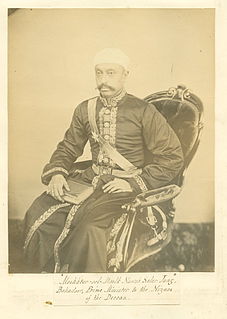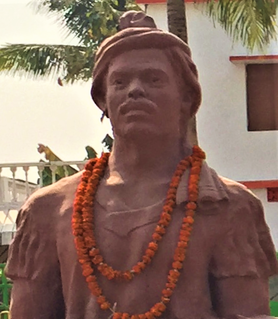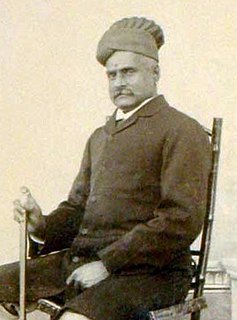 W
WJathedar Prahlad Singh was a Nihang Singh and 8th Jathedar of Shiromani Panth Budha Dal. He became Jathedar of Budha Dal in 1846 and also became Jathedar of Akal Takhat. He helped fight Nana Saheb and Bahadur Shah Zafar in the revolt of 1857. This is because Sikhs were loyal to the British and had been beaten in the Anglo Sikh wars. The Mughals also were intolerant to people of other faiths.
 W
WRao Sahib Ayyathan Gopalan, popularly known as "Darsarji"and "Darsar Sahib" ("doctor"), was an Indian physician, writer, philanthropist, and a social reformer. He is the founder of the Sugunavardhini movement and a leader and propagandist of Brahmo Samaj in Kerala. He denounced idol worship and fought to end those social practices in Kerala that he thought were unethical. Among his followers were Brahmananda Swami Sivayogi, Vaghbatananda, and Brahmavadhi P. Kunhiraman. Gopalan titled P. Kunhiraman as "Brahmavadhi" and Sivayogi as "Brahmananda Swami".
 W
WBahadur Shah Zafar or Bahadur Shah II was the last Mughal emperor. He was the second son of and became the successor to his father, Akbar II, upon his death on 28 September 1837. He was a nominal Emperor, as the Mughal Empire existed in name only and his authority was limited only to the walled city of Old Delhi (Shahjahanbad). Following his involvement in the Indian Rebellion of 1857, the British exiled him to Rangoon in British-controlled Burma, after convicting him on several charges.
 W
WChandan Hajuri popularly known as 'Chakhi Khuntia' was a Jagannath Temple priest and a poet who participated in the Indian Rebellion of 1857.
 W
WMahadev Desai was an Indian independence activist and writer best remembered as Mahatma Gandhi's personal secretary. He has variously been described as "Gandhi's Boswell, a Plato to Gandhi's Socrates, as well as an Ananda to Gandhi's Buddha".
 W
WDhan Singh Gurjar, also known as Dhunna Singh, was the Indian kotwal of Meerut, who participated in the 1857 rebellion and led initial actions against the British East India Company in Meerut.
 W
WNeil Benjamin Edmonstone (1765–1841) was a civil servant in and director of the East India Company.
 W
WMohammad Habib was an Indian historian, who worked at the Aligarh Muslim University. He was involved in the Indian Independence movement, and was an associate of both Gandhi and Jawaharlal Nehru.
 W
WJagabandhu Bidyadhara Mohapatra Bhramarbara Rai popularly known as "Bakshi Jagabandhu " or "Paika Bakshi" was the commander (Bakshi) of the forces of the king of Khordha. He is one of the earliest freedom fighters of India. The great Paika rebellion in 1817 was under his leadership. The BJB College in Bhubaneswar has been named after this great personality.
 W
WManibhai Jashbhai Mehta (1844–1900) was a dewan (minister) of Kutch and Baroda State during British India. He was the first person in Gujarat to receive the title of Dewan Bahadur. He played a key-role in the establishment of Oriental Institute, Baroda.
 W
WSayyid Babar Ali Khan Bahadur was the Nawab of Bengal, Bihar and Orissa. He succeeded to the Nawab's Masnad (throne) after his father, Mubarak Ali Khan died on 6 September 1793. He reigned from 1793 until 1810, when he died on 28 April 1810.
 W
WSir Mir Turab Ali Khan, Salar Jung I,, known simply as Salar Jung I, was an Indian nobleman who served as Prime Minister of Hyderabad State between 1853 until his death in 1883. He also served as regent for the sixth Nizam, Asaf Jah VI between 1869 and 1883.
 W
W'Samanta' Madhab Chandra Routray was the dalabehera, or the Paika unit commander of Tapanga, in the modern-day Khordha district of Odisha. He led a revolt against British East India Company forces in 1827. With the support of the local community, the warriors under his command withstood the British attack on Tapanga for seven days. He was eventually forced to surrender due to dwindling support, lack of resources, and a traitor passing information to the British from within the Paika ranks. However, Routray was later released as the British recognized his stature within the community and the risk of a mass uprising if he were harmed. He earned himself the title of 'Samanta,' or 'The commander of Ten Thousand Paikas', which was also given to his forefathers for their military services to the Gajapati king of Khordha.
 W
WMadhab Singh Bariha or Madho Singh was the Binjhal Zamindar (landlord) of Ghess locality of Bargarh district in Odisha and was a close associate of Veer Surendra Sa in the Sambalpur uprising against the British East India Company. He was hanged to death at the age of 72 on 31 December 1858 at Jail Chowk of Sambalpur, after being caught in the same year for his ferocious and heroic resistance to the British takeover of the region with their appalling policies. Three out of his four valiant sons were martyred while the eldest was sentenced to life imprisonment. His granddaughter Purnima committed suicide after the British hanged her rebellious husband from the Sonakhan Zamindari at Raipur.
 W
WMirza Jawan Bakht was the son of Emperor Bahadur Shah II, also called Zafar, and Zinat Mahal. He was the fifteenth son of his father and the only son of his mother. His mother nursed the ambition of placing him on the Mughal throne.
 W
WDhundiraj Govind Phalke, popularly known as Dadasaheb Phalke, was an Indian producer-director-screenwriter, known as the Father of Indian cinema. His debut film, Raja Harishchandra, was the first Indian movie in 1913, and is now known as India's first full-length feature film. He made 95 feature-length films and 27 short films in his career, spanning 19 years, until 1937, including his most noted works: Mohini Bhasmasur (1913), Satyavan Savitri (1914), Lanka Dahan (1917), Shri Krishna Janma (1918) and Kaliya Mardan (1919).
 W
WPindiki Bhubalendra was the Dalei of Daruthenga village of Khordha district in the Indian state of Odisha. He actively participated in the Paika Rebellion. The British excluded him from the amnesty provision. Instead he was treated as a high profile threat to the British authorities. He was shot dead at the age of 50 while trying to avoid a third episode of British captivity.
 W
WMewar Vibhuti, Pradhan Rai Pannalal Mehta (1843–1919) served four Maharanas, as Prime Minister of Mewar state in former state of Rajputana in India.
 W
WVembaukum Ramiengar CSI was an Indian civil servant and administrator who served as the Diwan of Travancore from 1880 to 1887.
 W
WRaja Hindu Rao was a Maratha nobleman, the brother-in-law of Maharaja Daulat Rao Scindia of Gwalior, and the brother of the female regent of the Indian princely state of Gwalior. Following the Revolt of 1857, he shifted to Delhi where he was on friendly terms with the British Resident. According to Emily Eden, sister of the then Governor General of India, Lord Auckland: "On a Revolution at Gwatia he retired to Delhi, where he now principally resides, and where he is well known in European society, with which he is fond of Mixing. Hindoo Rao is a very constant attendant on the person of the Governor-General wherever he may be in the neighbourhood of Delhi; making a point, generally, of joining his suite and riding with him on his morning marches."
 W
WSangolli Rayanna was an Indian military Shetsanadi (Sainik) and warrior in the Kittur princy state of the Karnataka. He was the Shetsanadi of the Kingdom of Kittur ruled at the time by Rani Chennamma and fought the British East India Company till his death. His life was the subject of the 2012 Kannada film Sangolli Rayanna.
 W
WDina Sanichar (1866-1894) was a feral child. Sanichar was discovered among wolves in a cave in Sikandra in Uttar Pradesh, India in 1872, at the age of 6, by a group of hunters from Bulandshahr. He went on to live among other humans for over twenty years, including picking up smoking, but never learned to speak and remained seriously impaired for his entire life.
 W
WZorawar Singh Kahluria was a military general of Dogra ruler Gulab Singh of Jammu, who was a vassal of the Sikh Empire. He served as the governor (wazir-e-wazarat) of Kishtwar and extended the territories of the kingdom by conquering Ladakh and Baltistan. He also boldly attempted the conquest of West Tibet but was killed in battle. In reference to his legacy of conquests in the Himalaya Mountains including Ladakh, Tibet, Baltistan and Iskardu as General and Wazir, Zorowar Singh has been referred to as the "Napoleon of India", and "Conqueror of Ladakh".
 W
WMuhammad Suleman Shah Taunsvi was a Sufi scholar and leader within the Chishti order of Sufism. He was born to the Jafar Pakhtun tribe of Darug, Loralai District, Balochistan province, in what is now Pakistan. His shrine lies in Tehsil Taunsa of district Dera Ghazi Khan of Punjab province in Pakistan. His urs is celebrated at his shrine every year from (5-7) Safar al-Muzaffar, second month of the Islamic Calendar.
 W
WAyya Vaikundar, also called Sriman Narayana Vaikundaswamy, is the tenth avatar or incarnation of Vishnu who worked for the upliftment of downtrodden people in the Kingdom of Travancore while in human form in the 19th century. He is central to the Hindu denomination of Ayyavazhi, as per the holy scripture, Akilathirattu.
 W
WRaja Ravi Varma was a celebrated Indian painter and artist. He is considered among the greatest painters in the history of Indian art. His works are one of the best examples of the fusion of European academic art with a purely Indian sensibility and iconography. Additionally, he was notable for making affordable lithographs of his paintings available to the public, which greatly enhanced his reach and influence as a painter and public figure. His lithographs increased the involvement of common people with fine arts and defined artistic tastes among common people. Furthermore, his religious depictions of Hindu deities and works from Indian epic poetry and Puranas have received profound acclaim.
 W
WPingali Venkayya was an Indian freedom fighter and the designer of the flag on which the Indian national flag was based. He was born at Bhatlapenumarru, near Machilipatnam, in what is now the Indian state of Andhra Pradesh.